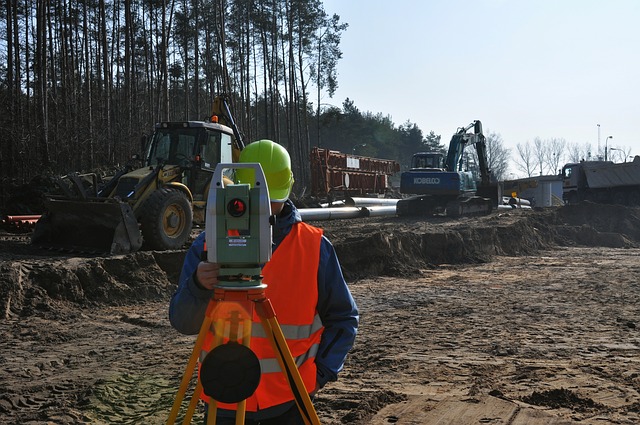Levelling in surveying
Contents |
[edit] What is levelling?
Levelling in surveying is the process of determining the height of one level relative to another. It is used to establish the elevation of a point relative to a datum, or to establish a point at a given elevation relative to a datum. This can be important when laying out or measuring buildings, other built assets and landscape.
For more information see: Levelling applications
[edit] What area the types of levelling instrument?
The main instruments used for levelling include:
- Dumpy level: Often a generic term for an optical level.
- Tilting level: Replaced by the automatic level but useful where vibration is a problem.
- Automatic level: Includes an internal pendulum which allows a horizontal reading.
- Laser level.
- Digital level: Staff read automatically.
- Water level: Useful in confined spaces.
For more information see: Surveying instruments.
[edit] How to take levels
The reticule is sometimes known as the cross-hairs or stadia hairs. The full horizontal line is the reference line for levelling and the 2 shorter lines above and below the full line are stadia lines for tacheometric measurements.
Care should be taken of staffs as well as levels as they are prone to damage. They should be inspected regularly for signs of wear. A common error is misreading the staff, so it is important that time is taken to ensure accurate readings.
The staff must be held vertical. The best ways to eliminate error are as follows:
- A small spirit level should be attached.
- Whilst standing upright the staff should be held in front with both hands down the side of the staff.
- The staff should be ‘rocked’ back and forth, and the lowest reading recorded.
- The verticality of the staff should be checked against a vertical line by standing to the side of the staff and checking it is aligned.
[edit] Booking observations
The steps to take when booking observations are as follows:
- A new job should be started on a new page of the levelling book.
- The details should be entered at the top of the page.
- All observations should be booked legibly. If a mistake is made it should be crossed out and the correct value written above it instead of overwriting figures.
- One line should be used for each position of the staff.
- There should always be an entry made in the remarks column.
- Work should be spread out appropriately.
There are two accepted methods for booking observations:
- Rise and Fall method
- Height of the Plane of Collimation method (HPC/HOC).
Neither method can be said to be more accurate than the other. Rise and Fall does have an additional check on the arithmetical reduction of the observations which makes it more popular on line levelling. The HPC method is used for setting out because one always needs to know the height of the instrument.
[edit] Related articles on Designing Buildings
Featured articles and news
C20 Society; Buildings at Risk List 2025
10 more buildings published with updates on the past decade of buildings featured.
Boiler Upgrade Scheme and certifications consultation
Summary of government consultation, closing 11 June 2025.
Deputy editor of AT, Tim Fraser, discusses the newly formed society with its current chair, Chris Halligan MCIAT.
Barratt Lo-E passivhaus standard homes planned enmasse
With an initial 728 Lo-E homes across two sites and many more planned for the future.
Government urged to uphold Warm Homes commitment
ECA and industry bodies write to Government concerning its 13.2 billion Warm Homes manifesto commitment.
From project managers to rising stars, sustainability pioneers and more.
Places of Worship in Britain and Ireland, 1929-1990. Book review.
The emancipation of women in art.
Call for independent National Grenfell oversight mechanism
MHCLG share findings of Building Safety Inquiry in letter to Secretary of State and Minister for Building Safety.
The Architectural Technology Awards
AT Awards now open for this the sixth decade of CIAT.
50th Golden anniversary ECA Edmundson awards
Deadline for submissions Friday 30 May 2025.
The benefits of precast, off-site foundation systems
Top ten benefits of this notable innovation.
Encouraging individuals to take action saving water at home, work, and in their communities.
Takes a community to support mental health and wellbeing
The why of becoming a Mental Health Instructor explained.
Mental health awareness week 13-18 May
The theme is communities, they can provide a sense of belonging, safety, support in hard times, and a sense purpose.
Mental health support on the rise but workers still struggling
CIOB Understanding Mental Health in the Built Environment 2025 shows.
Design and construction material libraries
Material, sample, product or detail libraries a key component of any architectural design practice.

























Comments
[edit] To make a comment about this article, click 'Add a comment' above. Separate your comments from any existing comments by inserting a horizontal line.
Levelling is usually performed with an automatic level and graduated staff rather than the total station in the picture.
This is a wiki site - so if you are unhappy with something, just click 'Edit this article' at the top of the page and change it.